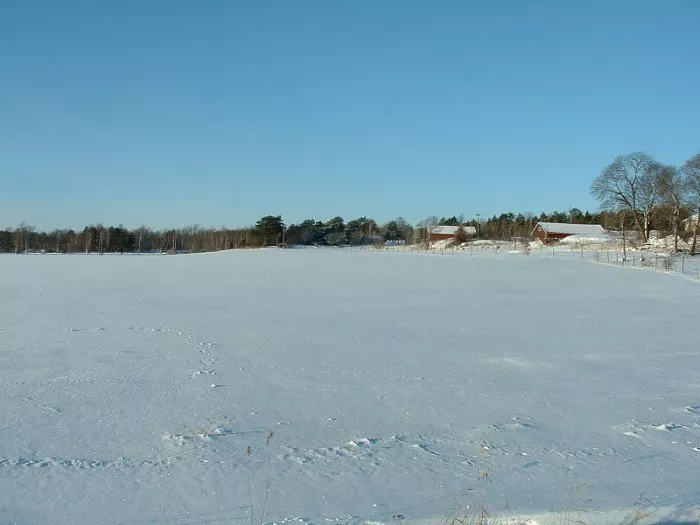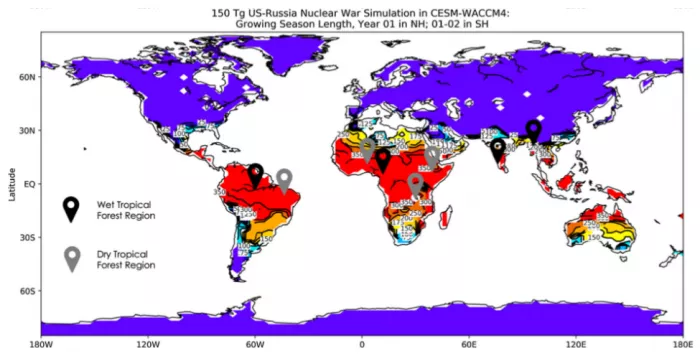On May 12, Beijing time, according to foreign media reports, can mankind grow food in the "nuclear winter"? If a nuclear war really breaks out, will it trigger a food crisis** Nuclear winter refers to the global temperature drop caused by the explosion of nuclear weapons. At that time, the global climate and environment will also change significantly. At present, researchers say that some crops can survive the nuclear winter and serve as human food. Since the cold war, the leaders of the United States and Russia have been highly vigilant against nuclear war. Even if there is a local exchange of nuclear weapons between countries, it will cause disastrous damage to the environment and society.

What impact may nuclear winter have on global food production? Two researchers from Pennsylvania State University pointed out that a small number of humans may survive the nuclear disaster, which is partly due to some wild edible plants and insects in the tropics.
Daniel Winstead, a research technology expert at Pennsylvania State University, and Michael Jacobson, a professor of forestry resources, conducted a special research to analyze the research project on emergency food recovery capacity. The research report was published in the Journal of human environment (Ambio) of the Royal Swedish Academy of Sciences in February this year. Recently, With the continuous exchange of fire between Russia and Ukraine, people's concerns about the nuclear weapons conflict have rekindled, making the study more relevant.

"I have no idea that this is related to any international current affairs. The timing of our research is really coincidental," said Winstead, the first author of the study
The sunlight decreases and the temperature decreases
The study pointed out that nuclear war is the most likely and most likely to be prevented in disasters that block out the sun, including volcanic eruptions, meteor impacts or supernova explosions.
Once the United States and Russia exchange fire with each other with about 4000 nuclear weapons (accounting for more than 90% of the total global nuclear weapons inventory), 165 million tons of soot will be emitted into the atmosphere, which is about 11 times the total weight of the three Giza pyramids.
According to the study report, the exchange of fire with nuclear weapons like this will reduce the exposure of sunlight near the equator to less than 40%, while the exposure of sunlight near the poles will be reduced to 5%. Temperate regions around the world will suffer severe cold and significantly reduce precipitation, which may take up to 15 years to fully recover.
Permafrost will gradually cover most parts of North America, Europe and Asia. In humid tropical forests, such as Congo or Amazon basin, precipitation may decrease by 90% in subsequent years.
In addition, the smoke and dust generated by large-scale nuclear war will lead to crop failure in the world for at least 4-5 years. However, in the tropical region closest to the equator, the rare extreme temperature changes will provide favorable opportunities for agricultural production and be able to feed disaster survivors, whether the sun shines immediately or can recover after a few years.
Edible wild plants
The study sought to determine which areas were adapted for agricultural production and what plants might grow effectively after nuclear war. To do this, the researchers identified population clusters in adjacent forests and tropical areas and selected tropical dry and wet forests for research and analysis. Next, they examined 247 wild edible plants (WEPS) and selected 33 plants that could be cultivated or collected by humans after nuclear war.
They divided edible wild plants into seven categories: leafy vegetables, seeds, nuts, roots, spices, sugary fruits and protein foods. The classification criteria of these edible wild plants include: richness, ease of processing, energy density, essential vitamins and minerals, long-term storage without refrigeration, and harvesting for most of the year. At the same time, the study pointed out that 33 edible wild plants were selected according to the characteristics of shade, drought and low temperature tolerance, although the number was small.
Winstead said that indigenous people know many wild plants and include some insects in their daily diet. Some tenacious creatures, such as palm weevil, which is a larva rich in fat and protein, can be roasted, ground into powder and made into bread and soup.
He also pointed out that the concentrated fat and protein of palm weevils contain high calories. 30-40 boxes (Tupperware fresh-keeping box) of palm weevils can meet a person's total calorie needs every day. What people have to do is to continuously collect palm weevils, put them in Tupperware fresh-keeping box and place them in the corner of the room, which is equivalent to a way of food storage.
Other edible wild plants include konjac, a root plant with high starch content, which can be used as a famine food; Cassava, known as the world's fifth largest high calorie plant; Wild oyster mushroom, a food source rich in protein, minerals, vitamins and antioxidants; Safou is an oily fruit, also known as "African plum". In addition, there are several wild spinach and amaranth. Amaranth is a common plant in Asia and Africa and is easy to cook.
The second type of edible wild plants are seeds and nuts that can be collected immediately after the nuclear war, not other crops to be planted after the disaster. They include palm fruit, tamarind fruit, dilo seed, Acacia seed, Sambi, baobab tree, yam and Ethiopian banana. Ethiopian banana is also known as one of the world's largest vegetables and "fake banana".
Winstead said: "It's basically a banana tree. People eat trees instead of bananas. During the famine in Ethiopia, many people rely on this plant to feed their hunger. Baobab is also very useful. Its water can be drunk indefinitely. Its fruit is nutritious and easy to store. People can also eat baobab's leaves and roots. Although I haven't eaten these edible wild plants yet, I really want to try it Down. "
Overall, Winstead hopes that through this research, people will improve their understanding of edible wild plants (in addition to proving how bad nuclear war is), so that we can eat them safely, both now and in the potentially disastrous future.
"Biodiversity not only enriches the world's species, but also has many uses. There are tens of thousands of edible plants around the world. More importantly, by protecting the areas where these plants grow, we will not lose biodiversity and ensure the availability of food after disasters," Winstead said
Although there are many varieties of edible plants, most of them only feed on 12 crops. Winstead believes that the "Westernization" of the global diet may lead to people losing their traditional understanding of wild plant food. Ancient tribal women have been responsible for collecting and preparing food. Their understanding of wild plant food has been passed on from generation to generation. However, with the development of modern industrialization, women know little about wild plant food.
Another problem is environmental protection. Winstead said that deforestation has endangered some wild spinach and some sweet potato plants are also at risk. Helping the recovery capacity of food production now can prepare us for future disasters. Of course, it is impossible to predict whether it will occur on the horizon and form a mushroom cloud.
"We have a lot of opportunities to do the right thing. We have enough land. If people are really willing to cooperate and don't hoard food for themselves, I think there will be many options, and some kind-hearted people need to make change decisions," Winstead said (Ye Qingcheng)